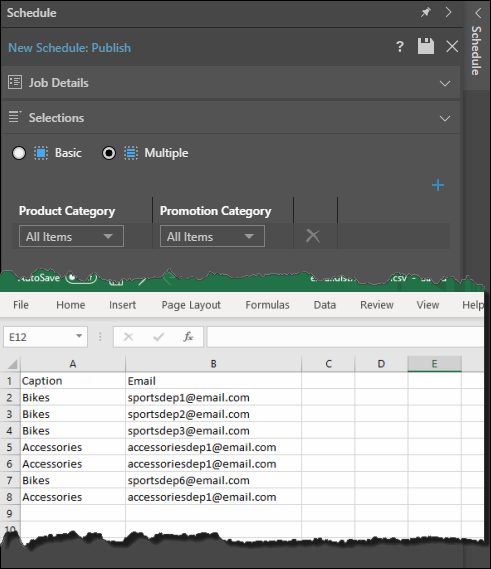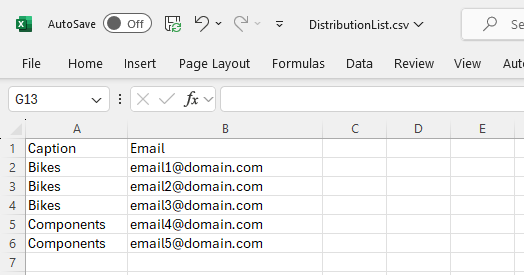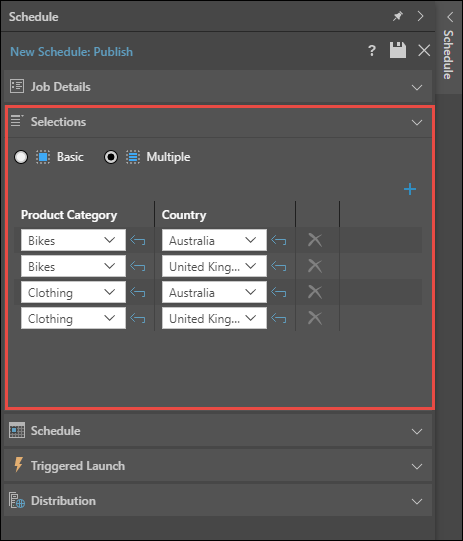The following are examples for creating a dynamic distribution list based on file mapping.
- Click here to learn about data mapping.
Example 1: Single Slicer
In this example, the Publication contains a single slicer, and two product categories are provided as the slices: Bikes and Accessories. Each copy of the report will be sent to the heads of the relevant departments; sporting equipment and accessories.
Step 1
Set the Schedule's Job Details, Selection, Schedule, and Triggered launch preferences.
- On the Selection panel, choose Multiple.
- Either select All Items, or choose the specific slices that are going to be imported in the email distribution list. See Step 3 for more information.
In this example, the distribution will be driven by the Product Category slicer:

Step 2
In the Distribution panel, select Email. Then select Dynamic email list (1), the Product Category slicer (2), and the File Mapping mapping method (3):

From the Map By drop down (4), select either Unique Name or Caption. Then click the Navigate button to browse to and select the distribution list from its file location. If successful, you'll see the File was uploaded successfully notification.
Configure the email template (5) as needed. Add shortcuts to your text as required (green highlight).
If the publication should be attached to the email, ensure this option is selected (6).
Note: You can distribute to both the bulletin board and email simultaneously; make sure Publish to bulletin board is not selected if this is not required.
Step 3
Click Save and Launch to run the schedule.
If more slices were selected under the Selections window than exist in the imported file, this will be reflected in the publication's job executions summary. For example, All Items was chosen under Selections. However, only two slices were specified in the uploaded file (Bikes and Components):

The Print and Export summary, therefore, shows that the distribution job did not run for the two slices that were not listed in the uploaded file (there was no Email target for either of the Accessories or Clothing captions):

Note: The purple arrow (above) indicates that the status of a distribution is failed. Scrolling along the details and selecting the value in the Error field shows that there is no recipient for this distribution (yellow arrow).
Example 2: Multiple Slicers
In this example, the publication contains two slicers: Product Categories and Country. The schedule is configured to produce reports filtered by Bikes in Australia, Bikes in the UK, Clothing in Australia, and Clothing in the UK. Each report generated will be sent to the head of sales for each product department in their respective country.
Step 1
Set the job details, selection, schedule, and triggered launch preferences.
Under Selection, choose Multiple and select the required slice combinations by which the report should be filtered. Be aware that if you select All Items, Pyramid will attempt to generate a publication for all possible slice combinations. So for performance reasons, you should select only the required combinations.

Step 2
From the Schedule panel, select Distribution and then the Email tab:
- Select Dynamic Email List.
- Choose the Slicer that should drive the email distribution.
- Choose File Mapping as your Mapping Method.
- From the first Map By drop-down, select either Unique Name or Captions. Next, upload the distribution list by clicking the button.
- Configure the Email Template as needed. Include shortcuts, if necessary (green highlight).
- Enable Attach content to attach the publication to the email.
Note: You can distribute to both the bulletin board and email simultaneously; make sure Publish to bulletin board is not selected if this is not required.

Step 3
Click Save and Launch to run the schedule.